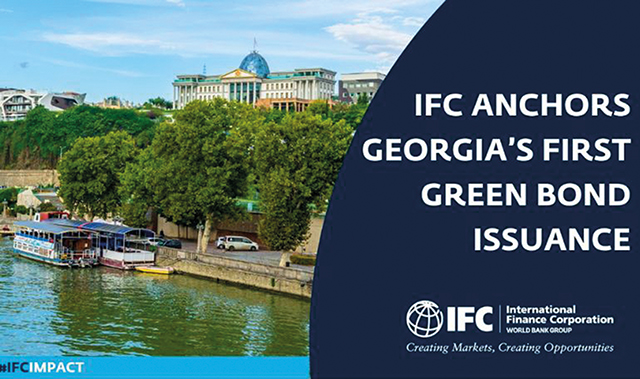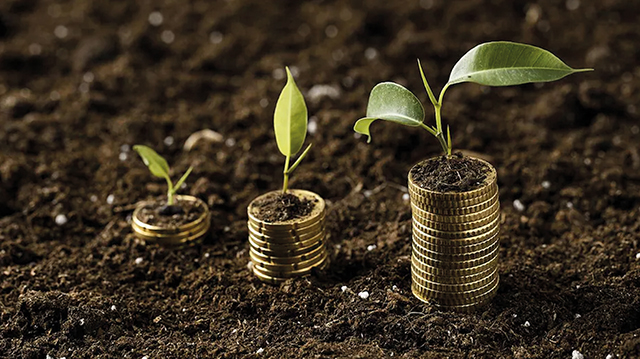By Sally White for Investor.ge
Investment opportunities in Georgia are accumulating, for fund managers, that is. Keeping abreast of the trends in international capital markets, Georgia has added a first domestically listed corporate green bond, which, at $80 million, is the largest such bond to be issued on the Georgian Stock Exchange. There are two aims for the bond: to develop Georgia’s energy and financial markets.
Designed for institutional and not private investors (so out of reach to any locals wishing to do their best for the planet at an attractive 7% rate of interest), the bond was still heralded by the international financial institutions (IFIs) as a significant move in the right direction. As one of these institutional investors, the World Bank’s financial arm the International Finance Corporation (IFC), commented: “The project complements ongoing World Bank efforts to support Georgia’s capital and fixed income markets development.” Strengthening Georgia’s capital markets has been a challenge that the IFIs have been working on for well over a decade.
Since taking part in this fundraising, the Asian Development Bank (ADB) has just approved a $100 million policy-based loan for “deepening” Georgia’s reforms of its capital markets, along with the country’s fiscal management, pension, and savings systems. ADB’s Central and West Asia Department is helping the government formulate a capital market development strategy.
It’s critical to connect environmental projects with capital markets and investors, and channel capital towards sustainable development – and green bonds are a way to make that connection
Explaining its plan for Georgia, the ABD said that traditionally Georgia had gone to European capital markets when it sought access to a “wider range of financiers and greater financing amounts.” This bond will bring both new stock market investment opportunities and new investors to Georgia, helping boost the local stock exchange and increase the country’s investment attraction, as well as improving local access to capital.
“The strategy’s overarching objective is to provide a roadmap for developing the capital market in a coordinated and sequenced manner. To guide the deepening of Georgia’s capital market, the strategy seeks to promote sustainable finance through the additional issuance of green and social impact bonds in the local securities exchange,” it added.

Georgia’s capital markets are becoming the center of a lot of activity. The government has the ambition of becoming a ‘regional financial hub’ and has also hired international financial advisory group Rothschild & Co. to advise it on capital markets, announcing early this year that: “Key priorities of the strategy are the attraction of foreign direct investments, creation of new employment opportunities, introduction of modern financial and technological innovations, promotion of robust financial centers, and development of the capital market in the country.”
The various problems perceived with Georgia’s capital markets are described (apart from the IFI references) in reports published by a number of commentators. These range from German foundation Bertelsmann Stiftung to the Georgian National Academy of Sciences (GSAS) and Asian Institute of Research, and the problems are seen as centering around the “bank-centric economic system” and a “practically non-existent” stock market. This, says the GSAS paper, “leaves the economy, especially the real sector, at the mercy of bank loans.” The restoration of the stock market “as an independent, strong and efficient body” is seen as a must.
Currently, the Georgian Stock Exchange, unlike even 15 years ago, regularly reports that it has seen no trading in either shares or bonds, with most of the country’s trading in recent years being done on the unofficial “gray” over-the-counter market. By contrast, the stock markets in Georgia’s neighbors are considerably more active.
Georgia’s new green bond
The issuer of the new green bond is Georgian Renewable Power Operations (GRPO), part of Georgian Renewable Power Holdings, one of the leading renewable energy platforms in Georgia and an affiliate of London Stock Exchange-listed investment group Georgia Capital. It owns and operates 71 MW installed capacity of commissioned renewable energy assets, including four hydro power plants and the only wind farm in Georgia.
GRPO will use the money “to support its ongoing operations,” refinancing a loan provided by Georgia Capital earlier this year. This financing will help boost renewable energy generation and energy independence in Georgia, “where over 30% of demand is met by imports and gas-fired thermal plants, and where electricity consumption is increasing.”
The restoration of Georgia’s stock market “as an independent, strong and efficient body” is seen as a must
The bond has been snapped up by Georgia’s leading investors, the major IFIs acting as “anchors” in order to get the issue launched with international commercial and retail investors. Timing is not auspicious, as, in spite of global interest in green bonds, financial uncertainty and Russia’s war against Ukraine have made markets extremely volatile globally, discouraging takers of new issues. The Dutch Development Bank, FMO, bought $40 million-worth, the ADB put in $4 million, the IFC took $20 million, and the European Bank for Reconstruction and Development (EBRD) took $14 million.

A number of green bonds have already been issued in Georgia, but they are not listed on the local market. For example, in July 2020, Georgia Global Utilities raised $250 million, listing the bond in Dublin, and this was followed in June of last year by a $500 million bond from Georgian Railways, which listed in London. Micro-finance group Crystal raised $5 million in May this year with a “sustainability” bond that is listed on the Luxembourg Green Exchange.
Global green bond market continues to grow
Globally, green or sustainable bond issuance (funds raised by the sale of bonds committed exclusively to financing or refinancing green projects, assets or business activities) has been climbing rapidly, responding to escalating fears globally following waves of environmental disasters. Debt related to green, environmental, and sustainable projects topped $1 trillion last year, with the bonds’ annual issuance rising above $500 billion for the first time. The figure for 2022 is forecast to again reach above $1 trillion, according to a study by certification body, the Climate Bonds Initiative. The spread of environment-protecting legislation has also made these bonds increasingly popular with both corporates and investors.
In the past few years, a rapidly increasing number of companies have issued green bonds, leading to a boom in the global green bond market in both primary and secondary trading. Issuance volume has nearly doubled every year since 2013. Investors have also increasingly become aware of the risks of climate change to their existing portfolios and, through mechanisms such as the Task Force on Climate-related Financial Disclosures (TCFD), they are also beginning to report on such risks. Additionally, stakeholders are pressuring the investment community to employ heighted environmental, social, and governance (ESG) policies and increase the transparency of their actions.
As a major proponent of green bonds, the World Bank, while painting the background picture for the GRPO bond, notes green bonds can help to secure a place for Georgia on the international financial map.
“Climate change threatens communities and economies, and it poses risks for agriculture, food, and water supplies. A lot of financing is needed to address these challenges. It’s critical to connect environmental projects with capital markets and investors and channel capital towards sustainable development – and green bonds are a way to make that connection.”
By Sally White for Investor.ge














